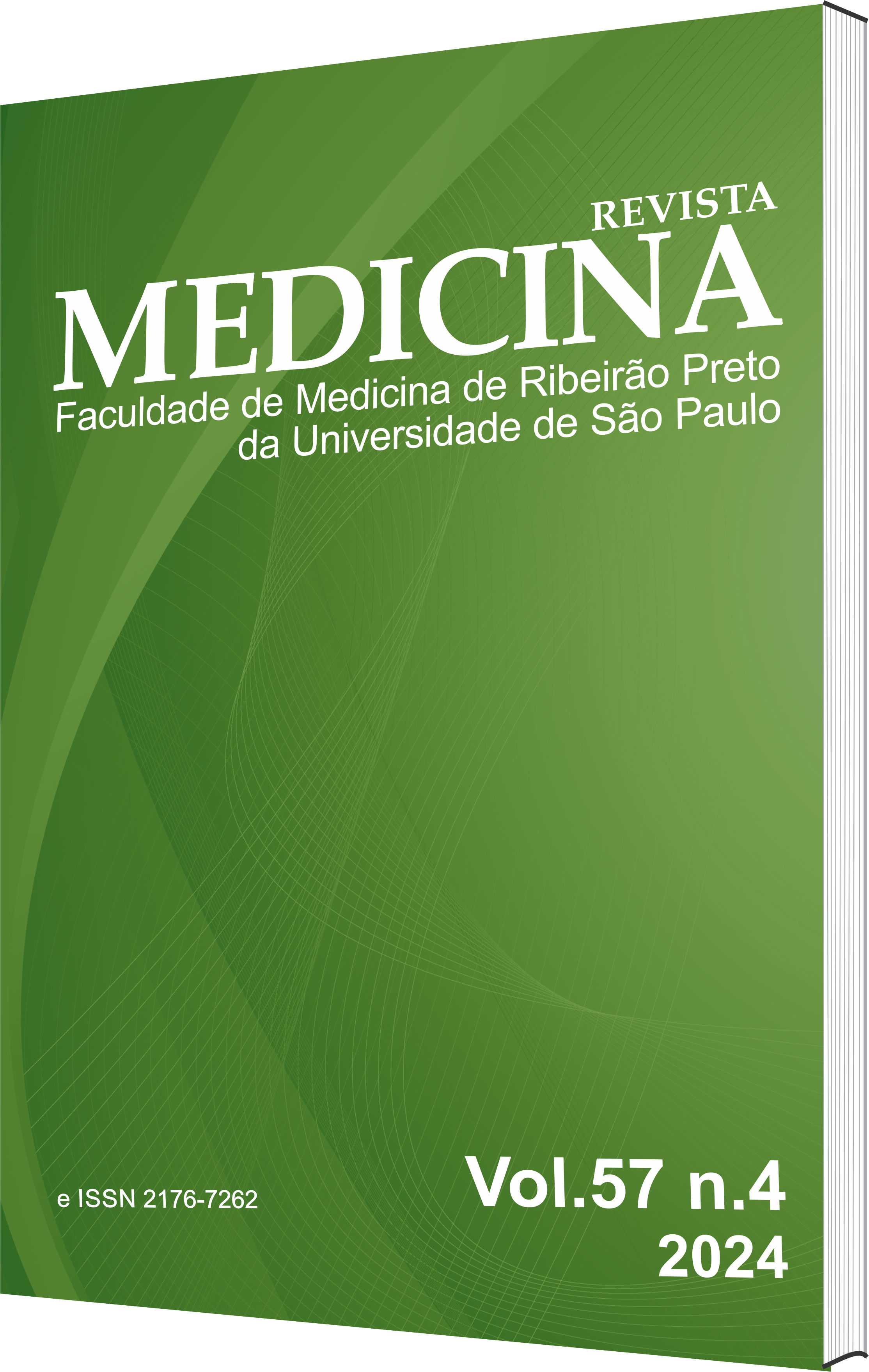Síndrome metabólica como fator de risco para nefrolitíase
DOI:
https://doi.org/10.11606/issn.2176-7262.rmrp.2024.203849Palavras-chave:
Nefrolitíase, Urolitíase, Cálculos urinários, Síndrome metabólicaResumo
Objetivo: Elucidar as principais características do paciente considerado de alto risco para a formação de nefrolitíase para melhor direcionamento na prevenção desta doença. Métodos: De setembro de 2019 a outubro de 2020, foi realizado um estudo prospectivo de 112 pacientes considerados de alto risco para a formação de cálculos no trato urinário, por meio de coleta de dados clínicos e investigação metabólica completa. Para análise dos dados, foi utilizado o programa estatístico Minitab 18®. Resultados: A média de idade foi de 46,76±13,53 anos, e a maioria apresentava sobrepeso /obesidade com IMC médio de 29,37±6.14 kg/m2. Predominou a raça caucasiana (68,75%) e 66,07% tinham histórico familiar. As alterações metabólicas mais destacadas foram: baixo volume urinário (77,68%), hipercalciúria (40,18%), hipocitratúria (39,29%), hiperuricosúria (33,04%). O estudo identificou que o sexo masculino (p=0,02; OR=2,10), IMC (p=0,00; OR=3,50), HAS (p=0,007; OR=1,53), DM (p=0,003; OR=4,99) e a dislipidemia (p=0,002; OR=2,84) representou forte probabilidade de contribuir para o evento litíase e as principais correlações e odds ratio foram entre a hipercalciúria e IMC alterado (p=0,001; OR=3,28), hipocitratúria e cálculo coraliforme (p=0,003; OR=2.21), hiperuricosúria e IMC alterado (p=0,017; OR=2,01), hiperoxalúria e IMC alterado (p=0,002; OR= 2,81), infecção urinária e DM (p=0,005; OR=1,73), infecção urinária do trato urinário e cálculo coraliforme (p=0,003; OR=1,77), paratormônio alterado e IMC alterado (p=0,008; OR =2,69) e hiperfosfatúria e IMC alterado (p=0,021; OR=1,99). Conclusão: Neste estudo, observou-se que a síndrome metabólica é um importante gatilho de alterações metabólicas em cálculos renais e, consequentemente, nefrolitíase, enfatizandoa necessidade de promover ou auxiliar políticas de saúde pública nessa população.
Downloads
Referências
Sakhaee K. Epidemiology and clinical pathophysiology of uric acid kidney stones. J Nephrol; 27: 241–245,2014.
Carpentier X, Chabannes E, Traxer O. Update for the management of kidney stones in 2013. Prog Urol.;24(5):319-26,2014.
Scholz D, Schwille PO, Ulbrich D. Composition of renal stones and their frequency in a stone clinic: relationship to parameters of mineral metabolism in serum and urine. Urol Res; 7:161–170,1979.
Daudon M, Lacour B, Jungers P. High prevalence of uric acid calculi in diabetic stone formers. Nephrol Dial Transplant;20: 468–469, 2005.
Pak CYC, Preminger GM, Ekeruo W. Biochemical profile of stoneforming patients with diabetes mellitus. Urology; 61:523–527, 2003.
Della GL, Roggi C, Cena H. Diet-induced acidosis and alkali supplementation. Int J Food Sci Nutr.;67(7):754-61, 2016.
Arrabal-Martín M, Domínguez-Amillo A, Cózar-Olmo JM. Factores etiopatogénicos de los diferentes tipos de urolitiasis. Arch Esp Urol.;70(1):40-50, 2017.
Daudon M, Frochot V, Jungers P. Drug-Induced Kidney Stones and Crystalline Nephropathy: Pathophysiology, Prevention and Treatment. Drugs;78(2):163-201, 2018.
Bianchi L, Cortegoso VP, Ruberto C. Renal lithiasis and inflammatory bowel diseases, an update on pediatric population. Acta Biomed; 17;89(9-S):76-80, 2018.
Treviño-Becerra A. Uric Acid: The Unknown Uremic Toxin. Contrib Nephrol.; 192:25-33, 2018.
Lancina Martín JA. Estudio metabólico. Cómo hacerlo accesible, útil y generalizado. Arch Esp Urol.; 70 (1): 71-90, 2017.
Minitab®, Quality. Analysis. Results and the Minitab logo are registered trademarks of Minitab, Inc., in the United States and other countries. Additional trademarks of Minitab Inc. can be found at www.minitab.com. All other marks referenced remain the property of their respective owners.
Korkes, F, Da Silva JL, Heilberg, Ita P. Custo do tratamento hospitalar da litíase urinária para o Sistema Único de Saúde brasileiro. Einstein. 9 (1): 518-22, 2011.
Wang S, Zhang Y, Zhang X, Tang Y, Li J. Upper urinary tract stone compositions: the role of age and gender. Int. braz j urol., v. 46, n. 1, p. 70-80,2020.
Wanderley EM, Ferreira VA. Obesidade: uma perspectiva plural. Ciênc. saúde coletiva, v. 15, n. 1, p. 185-194,2010.
Vigitel Brasil 2021 : surveillance of risk and protective factors for chronic diseases by telephone survey : estimates on the frequency and sociodemographic distribution of risk and protective factors for chronic diseases in the capitals of the 26 Brazilian states and in the Federal District in 2021 / Ministry of Health , Secretariat of Health Surveillance, Department of Health Analysis and Surveillance of Noncommunicable Diseases. – Brasilia: Ministry of Health, 2021.
Hsi RS, Kabagambe EK, Shu X. Race- and Sex-related Differences in Nephrolithiasis Risk Among Blacks and Whites in the Southern Community Cohort Study. Urology.;118:36-42, 2018.
García Nieto VM, Perez Suarez G, Moraleda Mesa T. The idiopathic hypercalciuria reviewed. Metabolic abnormality or disease? Nefrologia. 39 (6):592-602, 2019.
Zhang GN, Ouyang JM, Shang YF. Property changes of urinary nanocrystallites and urine of uric acid stone formers after taking potassium citrate. Mater Sci Eng C Mater Biol Appl.;33(7): 4039-45, 2013.
Li X, Li B, Yang L. Treatment of recurrent renal transplant lithiasis: analysis of our experience and review of the relevant literature. BMC Nephrol.; 23;21(1): 238, 2020.
Cupisti A, D’Alessandro C. Características metabólicas e dietéticas em formadores de cálculos renais: uma abordagem nutricional. Braz. J. Nephrol., v. 42, n. 3, p. 271-272, 2020.
Arrabal-Polo MA, Arrabal-Martin M, Garrido-Gomez J. Calcium renal lithiasis: metabolic diagnosis and medical treatment. Sao Paulo Med J.;131(1):46-53,2013.
Letendre J, Cloutier J, Valiquette L. Metabolic evaluation of urinary lithiasis: what urologists should know and do. World J Urol.;33(2):171-8, 2015.
Schwaderer AL, Wolfe AJ. The association between bacteria and urinary stones. Ann Transl Med.;5(2):32,2017.
Pazos PF. Uric Acid Renal Lithiasis: New Concepts. Contrib Nephrol.; 192:116-124, 2018.
Kaaroud H, Goucha R, Ben Abdallah T. Lithiase urinaire héréditaire: expérience d’un service de néphrologie. Prog Urol;29(16):962-973, 2019.
Pradere B, Le Balc'h É, Bensalah K. Lithiases urinaires et pathologies digestives: une revue de la littérature. Prog Urol; 25(10): 557-64, 2015.
Skolarikos A, Seitz C, Türk C. Metabolic evaluation and recurrence prevention for urinary stone patients: EAU guidelines. Eur Urol.; 67(4): 750-63, 2015.
Kotsiris D, Adamou K, Kallidonis P. Diet and stone formation: a brief review of the literature. Curr Opin Urol.;28(5): 408-413, 2018.
Downloads
Publicado
Edição
Seção
Licença
Copyright (c) 2024 Thiago Milani da Costa; Fabíola de Azevedo Mello, Juliana Machado Avila, Maria Julia Demattei de Melo, Marina Schroeder Iglesias, Sarah Duarte Silveira, Gabriela Reigota Blanco, Marcus Vinícius Pimenta Rodrigues, Renata Calciolari Rossi

Este trabalho está licenciado sob uma licença Creative Commons Attribution 4.0 International License.







